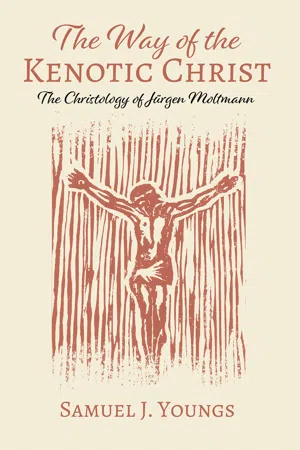![]()
PART I
Moltmann’s Theological Method and Christological Thematics
![]()
1
Distinctives of Moltmann’s Theological Approach
We begin by first identifying what I call the “christological center” of Moltmann’s theology. Not only is Moltmann’s theology holistically tethered by the centering force of his christological intuitions and arguments, but these are also the real source of the other, oft-assumed “centers” of his theology (such as his eschatology and his views on the Trinity). Once I describe this properly christological center in Moltmann, the remainder of the chapter focuses on elucidating various facets of his unique approach to the theological task. This elucidation is, of course, intended to empower our eventual consideration of his unique doctrine of Christ.
The Christological Center of Moltmann’s Theology
In his first major work, Theology of Hope, Moltmann claims that “from first to last . . . Christianity is eschatology.” He thereby establishes the eschatological focus that characterizes his thinking and, seemingly, pinpoints eschatology as the “center” of this thought. But it is immediately thereafter that he gives eschatology its own centering content, and that, explicitly, is Christology: “Christian eschatology speaks of Jesus Christ and his future. It recognizes the reality of the raising of Jesus and proclaims the future of the risen lord.” He further states that there “can be no Christology without eschatology and no eschatology without Christology.” The two loci are the mutually informing dialectic at the heart of his theological enterprise; his Christology is certainly an eschatologically oriented one, but Christian eschatology is content-less (indeed it could not and would not exist) without Christology.
In his next major (and “most enduring”) work, The Crucified God, it is the cross of Jesus Christ that is spoken of as “the center of all Christian theology. . . . It is in effect the entry to [theology’s] problems and answers on earth.” Theology’s fulcrum for Moltmann hereby comes to balance on staurological affirmations. But staurology, like eschatology, is completely hollow without Christology: “Christ the crucified alone is ‘man’s true theology and knowledge of God.’ . . . God’s being can be seen and known directly [sichtbar und direkt erkennbar] only in the cross of Christ.” Moltmann’s passionate rhetoric here echoes the young Luther’s theologia crucis. But whereas for Luther the cross had tremendous meaning for how we conceive the Christian life, for Moltmann it also forges a uniquely Christian path to thinking about God. The cross becomes Moltmann’s measure and criterion for all statements about divinity and the way in which God relates to the world—Christology and its cross are determinative for all. This is not only a matter of doctrinal content, but also of theological method, as John Webster notes:
Moltmann’s intense focus on a “crucified Christology” famously provides the base for his wide-ranging critique of classical theism while also springing the floodgates of his burgeoning social trinitarianism. In fact, as early as The Crucified God, Moltmann found the centermost point of discussing the Trinity in the cross of Christ, and it is this same sentiment that concludes his preface to The Trinity and the Kingdom only a few years later: “[The] cross of the Son stands from eternity in the centre of the Trinity.” Significantly, following Trinity and the Kingdom, it has been Moltmann’s highly dynamic, perichoretic, social model of the triune God that became his heuristic bridge into a vast spread of doctrinal territory. These new explorations were certainly catalyzed by trinitarian theology, but, as I have noted, for Moltmann the Trinity is only properly revealed in Christ and his cross.
Thus we can safely say that Moltmann’s Christology fundamentally precedes and constitutes his diverse theological trajectories; Christology is the hinge-point of his unique theological enterprise, as J. Scott Horrell implies:
Beyond serving as both the origination and framework for his robust trinitarian project, Moltmann’s Christology also funds his ethics—through his unique articulation of “christopraxis” and God’s kingdom (which is embodied in Christ’s very person, not just in his proclamation or actions)—as well as his ecclesiology, wherein the messianic family of the body of Christ enters into cruciform solidarity with the poor in an open friendship that imitates the other-seeking nature of Christ’s social relationships. Ecclesiology presupposes Christology fundamentally in Moltmann’s thought:
